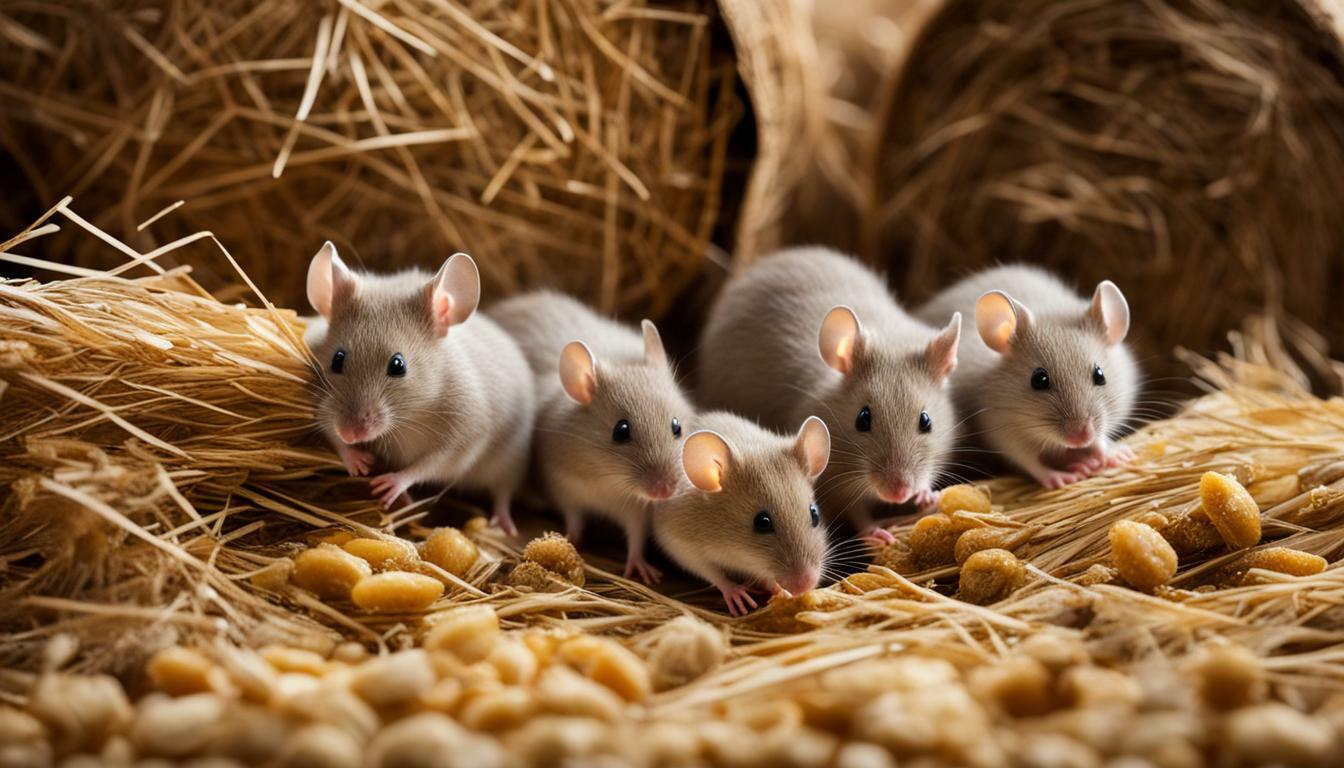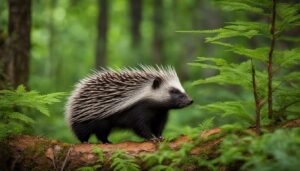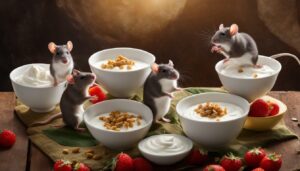If you’ve ever wondered whether mice eat hay, you’re not alone. Let’s uncover the truth about mice and their dietary habits.
Key Takeaways
- Mice are opportunistic omnivores, meaning they eat plants, seeds, grains, and insects.
- They enjoy variety in their diet and can be fed a muesli-style commercial mouse food.
- Gradually introduce new foods to prevent upset stomachs.
- Small amounts of fresh fruits and vegetables can be given as well as healthy treats like boiled or scrambled egg, mealworms, lean meat, beans, peas, and chickpeas.
- Feeding can be made more interesting by scattering pellets around the cage or hiding treats in paper bags or cardboard tubes.
What Do Mice Eat?
Mice are opportunistic omnivores, meaning they have a wide range of food preferences and can eat both plant-based and animal-based foods. They enjoy variety in their diet and can be fed a muesli-style commercial mouse food that provides a balanced nutrition. However, it is important to gradually introduce new foods to prevent upset stomachs.
In addition to the commercial food, small amounts of fresh fruits and vegetables can be given to mice. This can include safe options like carrot, broccoli, cabbage, cauliflower, chicory, sweet peppers, cucumber, cress, courgette, and peas. They also enjoy a variety of fruits such as apple, pear, peach, melon, dried banana, and red grapes. These fruits and vegetables can be provided as healthy treats and help add diversity to their diet.
Mice can also be given other animal-based foods such as boiled or scrambled egg, mealworms, lean meat, beans, peas, and chickpeas. These protein-rich options can be offered in small amounts as occasional treats. To make feeding more interesting, you can scatter pellets around the cage or hide treats in paper bags or cardboard tubes to encourage foraging behavior.
| Safe Fruits and Vegetables for Mice | ||
|---|---|---|
| Carrot | Broccoli | Cabbage |
| Cauliflower | Chicory | Sweet peppers |
| Cucumber | Cress | Courgette |
| Peas | Apple | Pear |
| Peach | Melon | Dried banana |
| Red grapes |
It’s important to note that mice enjoy chewing and gnawing on various items. They can safely chew on untreated softwood branches such as apple, dogwood, elm, grape, hawthorn, hazelnut, pear, poplar, quince, willow, and yucca. Additionally, items like cardboard, coconut shells, hay cubes, loofah, pumice stone, and seagrass can provide them with entertainment and help maintain their dental health.
Lastly, it is normal for mice to eat their own poo. They produce two types of feces – a softer pellet that is eaten because it is full of nutrients, and a harder, drier feces that can be discarded. This behavior helps to keep their gut healthy.
Summary:
Mice are opportunistic omnivores with a wide range of food preferences. Their diet can include muesli-style commercial mouse food, fresh fruits and vegetables, animal-based treats like egg and mealworms, and a variety of safe chewable items. Providing a diverse diet and incorporating foraging activities can help keep mice happy and healthy.
The Role of Hay in a Mouse’s Diet
While hay is commonly associated with larger herbivorous animals, such as rabbits and guinea pigs, there is some debate about whether mice can safely consume hay. In their natural habitat, mice primarily feed on seeds, grains, and insects, but they are also known to nibble on various types of vegetation. Hay, with its fibrous texture, serves as a valuable source of dietary fiber for many animals, aiding in digestion and promoting overall gut health. However, when it comes to mice, their ability to effectively digest and derive nutritional benefits from hay remains uncertain.
Mice are opportunistic omnivores, meaning they have a diverse diet that includes both plant and animal matter. Their feeding habits reflect their innate instinct to sample different food options. While hay may not be a primary component of a mouse’s diet, some experts believe that offering small amounts of hay can provide environmental enrichment and encourage natural foraging behaviors. However, it is important to note that hay should not replace a well-balanced mouse food that meets their specific nutritional requirements.
If you choose to introduce hay into your mouse’s diet, it is crucial to consider the quality and safety of the hay. Opt for a fresh, high-quality hay that is free from mold, dust, and other contaminants. It is also recommended to offer hay that is specifically intended for small animals, as it may be softer and more suitable for mice to nibble on. Observing your mouse’s eating habits and monitoring their overall health is essential to ensure that hay is well-tolerated and does not cause any digestive issues.
Conclusion
In conclusion, while hay can be offered to mice in small amounts as part of their diet, it is not a necessary or primary food source for them. Mice have diverse nutritional needs, and a well-balanced commercial mouse food should be the foundation of their diet. As with any dietary changes, it is important to introduce new foods gradually and monitor your mouse’s response. Always prioritize their health and consult with a veterinarian if you have any concerns or questions about their diet.
| Safe Fruits and Vegetables |
|---|
| Carrot |
| Broccoli |
| Cabbage |
| Cauliflower |
| Chicory |
| Sweet Peppers |
| Cucumber |
| Cress |
| Courgette |
| Peas |
| Apple |
| Pear |
| Peach |
| Melon |
| Dried Banana |
| Red Grapes |
The Ideal Mouse Diet and Food Options
To maintain a healthy and balanced diet, mice can be fed a muesli-style commercial mouse food, supplemented with fresh fruits and vegetables, as well as other nutritious treats. Mice are opportunistic omnivores, meaning they enjoy a variety of foods and can thrive on a diverse diet. Gradually introducing new foods is important to prevent upset stomachs, so take your time when introducing different options.
A muesli-style commercial mouse food serves as the foundation of a mouse’s diet. These products are specifically formulated to meet the nutritional needs of mice and come in a variety of flavors and textures to keep your furry friend interested. Alongside the commercial food, small amounts of fresh fruits and vegetables can be added to their diet. Some safe options include carrot, broccoli, cabbage, cauliflower, chicory, sweet peppers, cucumber, cress, courgette, peas, apple, pear, peach, melon, dried banana, and red grapes.
| Nutritious Treats | Chewable Items |
|---|---|
| Boiled or scrambled egg | Cardboard |
| Mealworms | Coconut shells |
| Lean meat | Hay cubes |
| Beans, peas, and chickpeas | Loofah |
| Pumice stone | |
| Seagrass |
Feeding can also be made more interesting by scattering pellets around the cage or hiding treats in paper bags or cardboard tubes. In addition to food, mice enjoy chewing and gnawing on various items. Safe options for them to chew on include untreated softwood branches like apple, dogwood, elm, grape, hawthorn, hazelnut, pear, poplar, quince, willow, and yucca. Providing these chewable items helps keep their teeth healthy and provides enrichment.
Remember that mice have a natural instinct to eat their own feces. While it may seem strange, this behavior is normal and beneficial to their health. They produce two types of feces: a softer pellet that is eaten because it is full of essential nutrients, and a harder, drier feces that can be discarded. By including a variety of foods, treats, and chewable items in their diet, you can ensure that your mice stay happy, healthy, and well-nourished.
Mice’s Food Chewing Habits and Other Considerations
Mice have a natural inclination to chew on various objects, including hay, as it helps to wear down their constantly growing teeth. Offering hay as part of their diet not only provides necessary roughage but also keeps their teeth in good condition. However, it’s important to ensure that the hay provided is of high quality and free from dust or mold which can be harmful to mice.
In addition to hay, mice enjoy gnawing on other items that can help satisfy their chewing instincts. Cardboard, coconut shells, hay cubes, loofah, pumice stone, and seagrass are some safe options that you can provide for them. These chew toys not only keep their teeth healthy but also provide mental stimulation and prevent boredom.
When it comes to their overall diet, mice are opportunistic omnivores and can eat a variety of foods. While a muesli-style commercial mouse food is a good base for their diet, it’s important to offer them a diverse range of options. This can include small amounts of fresh fruits and vegetables as well as healthy treats like boiled or scrambled egg, mealworms, lean meat, beans, peas, and chickpeas. Feeding can be made more interesting by scattering pellets around the cage or hiding treats in paper bags or cardboard tubes.
| Safe Fruits and Vegetables | |
|---|---|
| Carrot | Courgette |
| Broccoli | Peas |
| Cabbage | Apple |
| Cauliflower | Pear |
| Chicory | Peach |
| Sweet Peppers | Melon |
| Cucumber | Dried Banana |
| Cress | Red Grapes |
It’s worth noting that mice have a unique digestive system and occasionally eat their own feces, which might seem strange but is actually a normal behavior. This is because they produce two types of feces – a softer pellet that is eaten because it is full of nutrients, and a harder, drier feces that can be discarded. This process helps them extract maximum nutrients from their food and maintain a healthy gut.
By understanding mice’s food chewing habits and other considerations, such as providing appropriate chew toys and offering a varied diet, you can ensure that your furry friends stay happy, healthy, and entertained.
Conclusion
In conclusion, while mice may nibble on hay, it is not a necessary or essential part of their diet. As opportunistic omnivores, mice have a wide range of dietary preferences and can be fed a muesli-style commercial mouse food that provides them with the necessary nutrients. It is important to introduce new foods gradually to prevent any upset stomachs, and variety is key to keeping mice happy and healthy.
In addition to their commercial food, mice can enjoy small amounts of fresh fruits and vegetables as well as healthy treats like boiled or scrambled egg, mealworms, lean meat, beans, peas, and chickpeas. Feeding can be made more interesting by scattering pellets around the cage or hiding treats in paper bags or cardboard tubes, stimulating their natural foraging instincts.
Mice also have a natural instinct to chew and gnaw, which helps keep their teeth healthy and prevents them from becoming overgrown. Providing safe chewing materials such as cardboard, coconut shells, hay cubes, loofah, pumice stone, and seagrass can satisfy this need. Additionally, offering untreated softwood branches like apple, dogwood, elm, grape, hawthorn, hazelnut, pear, poplar, quince, willow, and yucca can provide them with natural materials to chew on.
Lastly, it is important to note that mice have a unique behavior of consuming their own feces. They produce two types of feces, a softer pellet that is eaten due to its high nutrient content, and a harder, drier feces that is discarded. This behavior helps them maintain a healthy gut and extract as many nutrients as possible from their food.
FAQ
Do mice eat hay?
Yes, mice do eat hay. Hay is an important part of a mouse’s diet as it provides fiber and helps maintain dental health.
What do mice eat?
Mice are opportunistic omnivores and eat plants, seeds, grains, and insects. A muesli-style commercial mouse food is a good base diet for them.
Can mice eat fruits and vegetables?
Yes, small amounts of fresh fruits and vegetables can be given to mice. Safe options include carrot, broccoli, cabbage, cucumber, and apple.
What other foods can be given to mice as treats?
Mice can enjoy treats like boiled or scrambled egg, mealworms, lean meat, beans, peas, and chickpeas in small amounts.
What materials can mice safely chew on?
Mice enjoy chewing on items like cardboard, coconut shells, hay cubes, loofah, pumice stone, and seagrass. Untreated softwood branches such as apple, pear, and willow are also safe for them to chew.
Is it normal for mice to eat their own poo?
Yes, it is normal for mice to eat their own poo. They produce two types of feces, one that is softer and full of nutrients, and another that is harder and drier and can be discarded.




